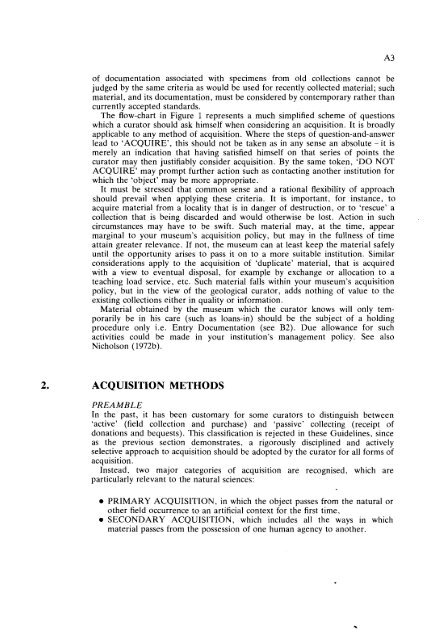GUIDELINES FOR THE CURATION OF GEOLOGICAL MATERIALS
GUIDELINES FOR THE CURATION OF GEOLOGICAL MATERIALS
GUIDELINES FOR THE CURATION OF GEOLOGICAL MATERIALS
Create successful ePaper yourself
Turn your PDF publications into a flip-book with our unique Google optimized e-Paper software.
of documentation associated with specimens from old collections cannot be<br />
judged by the same criteria as would be used for recently collected material; such<br />
material, and its documentation, must be considered by contemporary rather than<br />
currently accepted standards.<br />
The flow-chart in Figure 1 represents a much simplified scheme of questions<br />
which a curator should ask himself when considering an acquisition. It is broadly<br />
applicable to any method of acquisition. Where the steps of question-and-answer<br />
lead to 'ACQUIRE', this should not be taken as in any sense an absolute - it is<br />
merely an indication that having satisfied himself on that series of points the<br />
curator may then justifiably consider acquisition. By the same token, 'DO NOT<br />
ACQUIRE' may prompt further action such as contacting another institution for<br />
which the 'object' may be more appropriate.<br />
It must be stressed that common sense and a rational flexibility of approach<br />
should prevail when applying these criteria. It is important, for instance, to<br />
acquire material from a locality that is in danger of destruction, or to 'rescue' a<br />
collection that is beine " discarded and would otherwise be lost. Action in such<br />
circumstances may have to be swift. Such material may, at the time, appear<br />
marginal to your museum's acquisition policy, but may in the fullness of time<br />
attain greater relevance. If not, the museum can at least keep the material safely<br />
until the opportunity arises to pass it on to a more suitable institution. similar<br />
considerations apply to the acquisition of 'duplicate' material, that is acquired<br />
with a view to eventual disposal, for example by exchange or allocation to a<br />
teaching load service, etc. Such material falls within your museum's acquisition<br />
policy, but in the view of the geological curator, adds nothing of value to the<br />
existing collections either in quality or information.<br />
Material obtained bv the museum which the curator knows will onlv temporarily<br />
be in his car; (such as loans-in) should be the subject of a holding<br />
procedure only i.e. Entry Documentation (see B2). Due allowance for such<br />
activities could be made in your institution's management policy. See also<br />
Nicholson (1972b).<br />
ACQUISITION METHODS<br />
PREAMBLE<br />
In the past, it has been customary for some curators to distinguish between<br />
'active' (field collection and purchase) and 'passive' collecting (receipt of<br />
donations and bequests). This classification is rejected in these Guidelines, since<br />
as the previous section demonstrates, a rigorously disciplined and actively<br />
selective approach to acquisition should be adopted by the curator for all forms of<br />
acquisition.<br />
Instead, two major categories of acquisition are recognised, which are<br />
particularly relevant to the natural sciences:<br />
PRIMARY ACQUISITION, in which the object passes from the natural or<br />
other field occurrence to an artificial context for the first time,<br />
SECONDARY ACQUISITION, which includes all the ways in which<br />
material passes from the possession of one human agency to another.

















